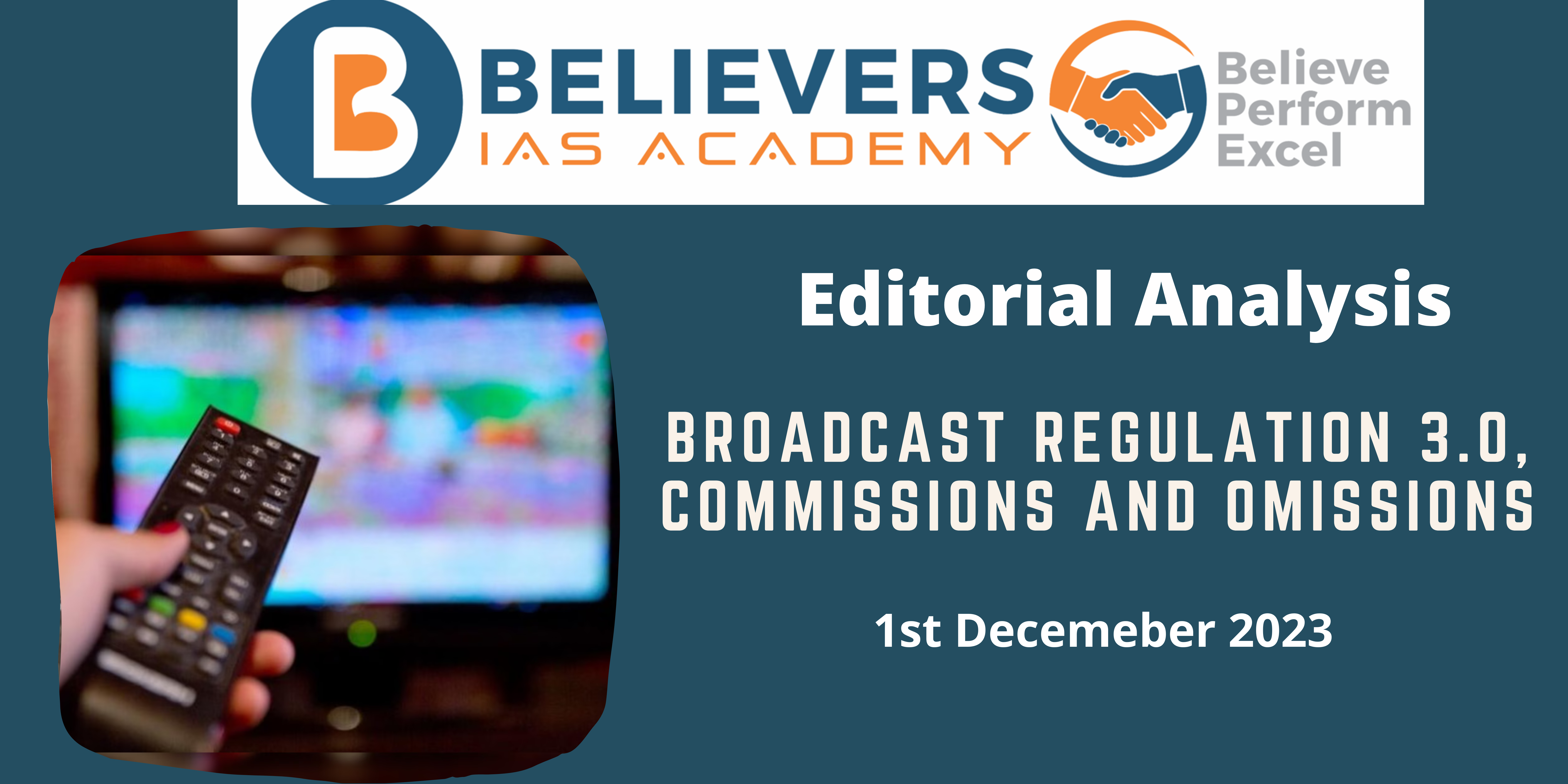Broadcast regulation 3.0, commissions and omissions
Context:
The recently unveiled Broadcasting Services (Regulation) Bill by the Ministry of Information and Broadcasting marks another attempt in the journey of regulating broadcasting comprehensively.
Background:
The previous endeavors, notably in 1997 and 2007, aimed at crafting an integrated framework for this sector. The current bill introduces positive aspects like data transparency, audience measurement methodology, and involvement of private players in terrestrial broadcasting. However, concerns arise, particularly regarding the inclusion of Over-the-Top (OTT) content suppliers in the definition of broadcasting services and the lack of focus on ownership issues.
Relevance:
GS – 2, GS – 3 (Government Policies & Interventions, Right to Information, IT & Computers, Science & Technology, Internal Security Challenges, Cyber Security)
Prelims:
Broadcasting Services (Regulation) Bill, 2023, Cable Television Networks Regulation Act of 1995, OTT platforms, Digital media regulation.
Mains Question:
Critically analyze the Broadcasting Services (Regulation) Bill, focusing on its potential impact on media diversity, press freedom, and the challenges it poses to content creators and broadcasters. (150 words)
Key Highlights of the Draft Broadcasting Regulation Bill, 2023
- Consolidation and Modernization: The bill addresses the longstanding need for a unified legislative framework, consolidating and updating regulatory provisions for various broadcasting services, including over-the-top (OTT) content and digital news.
- Contemporary Definitions and Future-Ready Provisions: Introduces comprehensive definitions for modern broadcasting terms and incorporates provisions for emerging technologies.
- Strengthened Self-Regulation Regime: Enhances self-regulation through ‘Content Evaluation Committees’ and transforms the Inter-Departmental Committee into a more participative ‘Broadcast Advisory Council.’
- Differentiated Codes: Allows a differentiated approach to Programme and Advertisement Codes, necessitating self-classification by broadcasters and robust access control for restricted content.
- Accessibility for Persons with Disabilities: Addresses the specific needs of persons with disabilities by incorporating enabling provisions for comprehensive accessibility guidelines.
- Statutory Penalties and Fines: Introduces statutory penalties like advisory, warning, censure, or monetary penalties, with imprisonment and/or fines reserved for very serious offenses.
- Equitable Penalties: Links monetary penalties and fines to the financial capacity of the entity, ensuring fairness by considering investment and turnover.
- Infrastructure Sharing, Platform Services, and Right of Way: Includes provisions for infrastructure sharing, platform services, and streamlines Right of Way for efficient relocation and alterations. Establishes a structured dispute resolution mechanism.
Dimensions of the Article:
- Positive Propositions and Concerns
- Privacy Implications and News Media Constraints
- Ownership Issues and Regulatory Framework
- Government Empowerment and Press Freedom
Positive Propositions and Concerns:
- The Bill introduces positive propositions, such as maintaining subscriber data records, transparent audience measurement, and allowing private actors in terrestrial broadcasting. However, these aspects need refinement, especially in safeguarding subscriber privacy and ensuring diversity in broadcasting.
- Concerns arise with the inclusion of OTT content suppliers in the definition of broadcasting services, potentially affecting media outlets and content creators.
Privacy Implications and News Media Constraints:
- The Bill lacks protective measures for subscriber privacy, raising concerns about data collection practices. Moreover, the expanded definition of broadcasting may limit the conditions under which journalists and non-mainstream news outlets can operate.
- The introduction of a ‘Content Evaluation Committee’ for self-certification of news programming poses feasibility and desirability challenges.
Ownership Issues and Regulatory Framework:
- Notably silent on ownership matters, the Bill overlooks the crucial aspects of cross-media and vertical ownership, which impact the diversity of news suppliers.
- The absence of an independent broadcast regulator, as hinted in TRAI’s paper, is a gap that requires attention.
- Instead, the proposed ‘Broadcast Advisory Council’ raises concerns about its capacity, autonomy, and the government’s ultimate authority over its decisions.
Government Empowerment and Press Freedom:
- Granting the government the power to inspect broadcasters without prior notice, impound equipment, and intervene in the name of “public interest” heightens the vulnerabilities of news suppliers.
- The undefined term “public interest” leaves room for subjective interpretation, posing a potential threat to press freedom. Violations of the Programme Code and Advertisement Code carry severe consequences, impacting the freedom of content creators.
Way Forward:
- The Broadcasting Services (Regulation) Bill presents an opportunity to shape the future of broadcasting regulation in India. To safeguard press freedom and media diversity, the bill should address privacy concerns, refine oversight mechanisms, and consider the implications of including OTT content suppliers.
- A nuanced approach is crucial to balance regulatory measures with the need for a vibrant and diverse media landscape. The legislators must seize this opportunity to create a framework that fosters responsible broadcasting while upholding the principles of freedom and diversity in the media sector.




